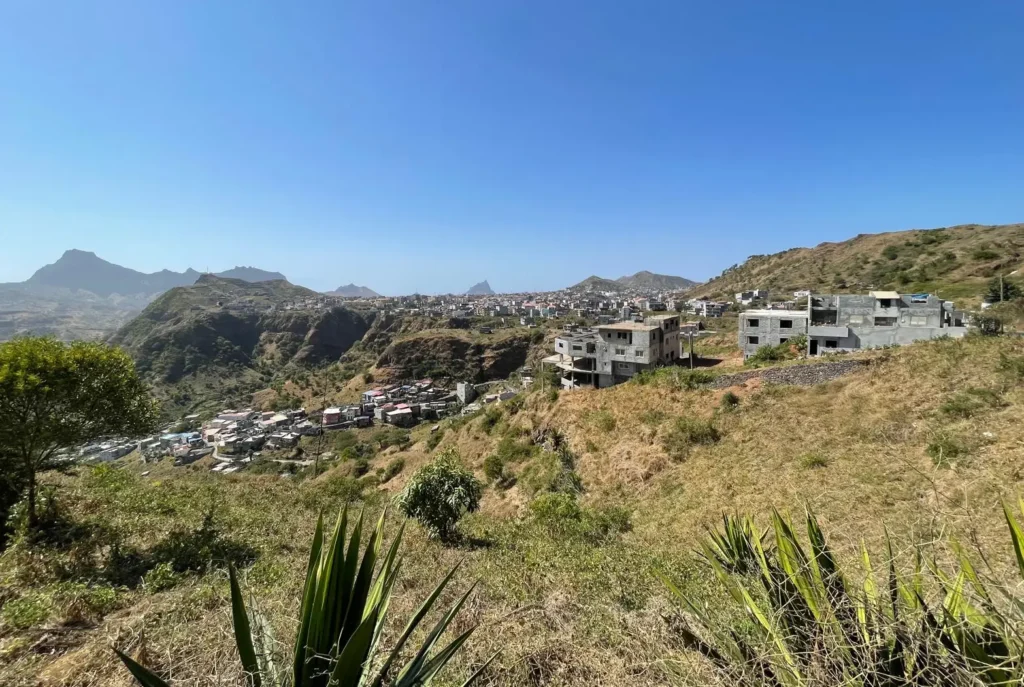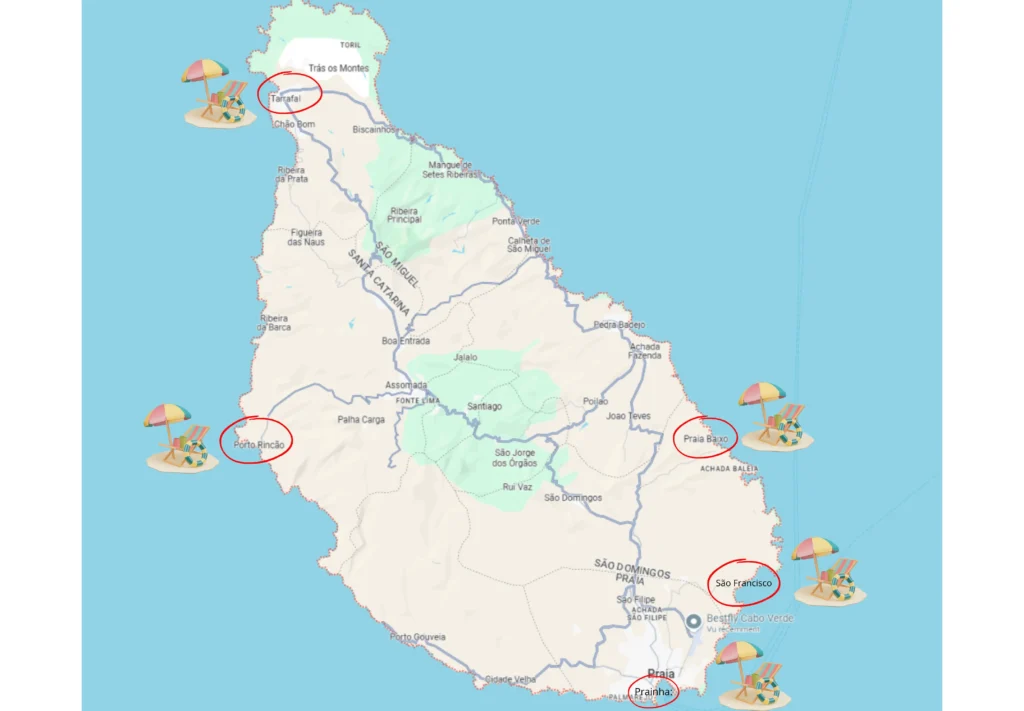What to do in Santiago, Cape Verde Guide and tips
The largest island in the Cape Verde archipelago, Santiago offers a fascinating blend of African and Portuguese culture, mountainous landscapes and unspoilt beaches. The historic cradle of Cape Verde, it is home to Praia, the country’s capital, as well as hidden treasures just waiting to be explored. Wondering how to make the most of this authentic island? Discover our travel guide to help you plan your itinerary.
Table of contents
How do I get to Santiago?
- Praia Nelson Mandela International Airport
Located in the heart of the archipelago, Santiago is easily accessible. Praia’s Nelson Mandela International Airport handles direct flights from Europe and West Africa. It is also a major hub for domestic flights, with daily connections to all the Cape Verde islands.
The airport is just 3 km to 6 km from the center of Praia, depending on your exact destination. A cab will take you there in 10 or 15 minutes for around 15 euros. The main airlines serving the airport are TAP Air Portugal, Royal Air Maroc and, of course, local companies Binter CV and BestFly.
- Sea connections
For a more authentic experience, opt for sea connections to visit other Cape Verde islands from Santiago. Ferries regularly link Santiago to neighboring islands such as Fogo and Maio. The CV Interilhas company offers regular connections with different types of ship.
💡 Travel tip: International flights to Santiago are often cheaper than those to the more touristy islands of Sal and Boa Vista. It’s an excellent gateway to discover the archipelago! However, this often means planning a transfer.
Exceptional natural sites – a must-see
Santiago offers some of the archipelago’s most spectacular scenery. From majestic mountains to lush valleys, every hike is full of surprises.

- Serra Malagueta: hiking and unique biodiversity
Serra Malagueta Nature Park boasts unique biodiversity. At an altitude of 1,394 metres, its signposted trails lead you through a tropical forest home to endemic species. The views of the ocean are breathtaking. There are hikes of varying lengths and difficulty. Take along a local guide for your safety, but also to learn about the country’s history.
- The Poilão de Boa Entrada: a century-old sacred tree
A must-see, this mythical Santiago tree is a giant, centuries-old cheesemaker that impresses with its monumental size. The locals consider it sacred and gladly share its legends with visitors. This mystical site near the town of Assomada is easily accessible from Praia.
- Ribeira Principal: a green valley and traditional agriculture
The valleys of Ribeira Principal plunge you into another Cape Verde. These verdant oases are home to terraced farming and traditional villages. The contrast with these arid landscapes is striking. This is an important agricultural area for the island.
- Ribeira Grande de Santiago: a historic colonial valley
Located near Cidade Velha in the west of the island, this valley is of particular historical importance. It was here that Africa’s first colonial town developed. Its landscapes and historical heritage make it an unmissable place to visit.
- Monte Graciosa: breathtaking panoramas
This is one of the island’s most breathtaking panoramas. From the summit, you can admire Tarrafal Bay on one side and the Serra Malagueta mountains on the other. The hike is of moderate difficulty, accessible to those in good physical condition.
- Aguas Belas: waterfalls and natural springs
These waterfalls offer an impressive spectacle during the rainy season. During the dry season, when the flow is lower and the water clearer, some waterholes may be suitable for swimming. Always ask the locals about safety conditions.
💡 Tip : Leave early in the morning to take advantage of the cooler weather and the best visiting conditions. A local guide will enrich your experience with his knowledge of the area.
The most beautiful beaches and bays on Santiago Island
Santiago will surprise you with the diversity of its beaches. From secluded coves to vast stretches of sand, each has its own unique character. Here are a few ideas of beaches to visit.

- Tarrafal Bay: a veritable tropical paradise, with white sand fringed by coconut palms and turquoise waters. This protected bay offers the best bathing conditions on the island. The small fishing village nearby offers fresh seafood restaurants.
- Prainha: nestled in a protected cove off Praia, this golden sand beach is the capital’s most beautiful. Its calm waters and peaceful setting make it a haven of tranquillity just a few minutes from the city center.
- Porto Rincão: on the west coast, discover this beautiful black sand beach with its spectacular volcanic cliffs. Particularly popular with locals at weekends, it offers a great opportunity to sample fresh fish in the small restaurants.
- Praia Baixo: on the east coast, this black sand beach impresses with its volcanic landscape. Popular with locals for its fishing spots, it is also home to a number of local restaurants.
- São Francisco: a favorite spot for surfers thanks to its regular waves of varying strength. For beginners, there’s a surf school with qualified instructors. The beach stretches for several kilometers, perfect for long strolls. The sunsets are spectacular.
💡 Beach tip: Santiago’s beaches are less crowded than those of Sal or Boa Vista. Make the most of them for a more authentic experience!
Historical and cultural heritage for local immersion
Santiago is the historic cradle of Cape Verde. The island abounds in cultural treasures and unique historical sites that tell the fascinating story of the archipelago.
- Cidade Velha: the first colonial city built in Africa, a UNESCO World Heritage Site. Visit its royal fortress perched on a cliff, the Nossa Senhora do Rosário church (the oldest colonial church in the world) and the Pelourinho, a vestige of the slave era. The cobbled streets of the historic district take you back to the 15th century.
- Praia, the lively capital: the Plateau district, the historic heart of the city, surprises with its colorful colonial architecture. The Municipal Market is bursting with life and spicy smells. Don’t miss the Presidential Palace and its gardens, testimony to the country’s independence.
- Assomada Market: the beating heart of Santiago Island. Located in the town of Assomada, in the center of Santiago Island, this market is the largest and liveliest in Cape Verde. It offers an authentic immersion in local life and Cape Verdean culture. More than just a place to shop, it’s a true meeting place, where locals come together to socialize and share convivial moments.
- The Ethnographic Museum: housed in an old colonial building, it features a fascinating collection of traditional objects. Discover the history of the island’s settlement and the evolution of its unique culture, a blend of African and European influences.
- Traditional villages: inland, villages such as São Domingos and São Jorge dos Órgãos perpetuate Cape Verdean traditions. Music festivals, weekly markets and traditional festivities are all part of local life. Here you can enjoy morna and other forms of traditional Cape Verdean music.
💡 Culture tip: Unlike the more touristy islands, Santiago has preserved a rare authenticity. It’s the ideal place to discover true Cape Verdean culture!
Activities and experiences typical of this Cape Verdean island
Santiago Island offers a multitude of unique activities. More wild and authentic than its neighbors, it will delight travelers in search of true experiences.
- Hiking and trekking: The island is a hiker’s paradise. The Serra Malagueta trails take you through spectacular volcanic landscapes. The lush green valleys of Ribeira Principal offer gentler walks, between coffee plantations and traditional villages. Choose a local guide to discover secret paths and endemic flora.
- Diving and snorkeling: Santiago’s waters are home to a rich variety of marine life. Tarrafal Bay is ideal for observing turtles and tropical fish. Diving centers offer trips for all levels.
- Local gastronomy: Taste authentic Cape Verdean cuisine in local restaurants. The catchupa (national stew), freshly caught grilled fish and tropical fruits will surprise you. Don’t miss a tasting of grogue, the local rum produced in the island’s valleys.
- Cultural immersion: Take part in a traditional dance class, discover the secrets of local cuisine or join a music festival. The people of Santiago are proud to share their culture. A simple coffee in a local bar can turn into an impromptu Creole lesson!
💡 Experience tip: For total immersion, rent an apartment to mingle with local life. You’ll be free to discover the island’s hidden treasures.
Practical advice for a successful trip to Cape Verde
Here’s all the information you need to make the most of your stay in Santiago and enjoy the island to the full.
The best time to visit is from November to June, when the climate is dry and pleasant. Temperatures oscillate between 22 and 28°C, ideal for outdoor activities. Avoid the rainy season (July-October), which may limit some excursions.
Where to stay? There are several options to choose from, depending on your requirements:
- In Praia: the ideal choice for city dwellers, with numerous hotels to suit all budgets.
- In Tarrafal: perfect for beach and relaxation, charming B&Bs
- Inland: self-catering cottages or apartments for rent for total immersion.
Average prices range from €30 for a single room to €120 for a top-of-the-range hotel.
Getting around the island ? Here’s some practical information. If you’d like to find out more, read our practical guide to getting around Cape Verde.
- Aluguers, also known as collectivos (collective minibuses), are economical and specific to Cape Verde. It’s an opportunity to mingle with the local population. However, you’ll need to be patient about the journey time.
- Cabs are convenient in town. Be sure to ask for the fare before you get in.
- Car rental starts at €40/day. It’s an ideal way to explore the island freely.
- Motorcycles are perfect for mountain roads, but you should check with the locals before setting off.
Don’t forget your essential equipment. :
- walking shoes for hikes
- sun protection factor 50 and a hat
- bathing suit and beach towel
- light but covering clothing to respect the local culture
💡 Budget tip: Santiago is cheaper than Sal or Boa Vista. Choose local restaurants and public transport to optimize your budget.
In conclusion, Santiago offers an authentic Cape Verde experience, far removed from mass tourism. Between unspoilt nature, vibrant culture and wild beaches, the island satisfies all travelers curious to discover the true Cape Verdean spirit. Its accessibility and affordable prices make it an ideal destination for exploring the archipelago in a different way.
